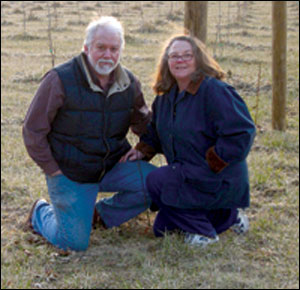|
Roots of a Career

Cultivating a lifelong connection with the land, Dan Terlizzi and his wife Cecilia found a fulfilling empty nest project in growing wine grapes near their Maryland home.
Credit: Dan Terlizzi. |
DAN TERLIZZI'S INTEREST IN FARMS has roots that are both personal and professional. Though primarily focused on algae and marine water quality issues as a Sea Grant Extension specialist, his interest in plant physiology and behavior of more traditional crops goes way back. His wife Cecilia grew up on a farm and he started dating her when he was 15. "Our dates involved pitching hay and helping on the farm. They needed her help, so if I wanted to spend time with her, I had to help too."
Terlizzi and his wife ended up building a house on the family farm northwest of Baltimore and "put a big stake in the ground by doing so." They moved in 1981 and still live there today. Now that their two sons are grown, they've started cultivating wine grapes. The idea has percolated since a sabbatical in Italy several years ago, and the Terlizzis now plan to sell their grape harvest to the local wine industry.
As an undergraduate at St. Mary's College, Terlizzi studied biology with a marine spin, an interest that he'd cultivated since his early childhood in Bermuda as a "military brat." Though he found himself gravitating toward the study of phytoplankton ecology, he realized that everything about the discipline was grounded in basic physiology. So he chose a traditional plant physiology program at the University of Maryland, one that broadened his focus to understand how physiological processes compared between algae and traditional crop plants like corn and soybeans. His "aha" academic moment came during a course in plant mineral nutrition. It was the "perfect course at the perfect time," he says, making him think deeply about nitrogen and phosphorus in the Bay, an area of focus that has defined his career ever since.
After finishing his Ph.D., Terlizzi did soybean herbicide work for the U. S. Department of Agriculture and then worked in the private sector for about 10 years. When the opportunity came up to return to the University of Maryland through Sea Grant Extension, he was delighted to come back into the university system. He started off doing marine extension agent work out of a county office. Although he enjoyed interacting with clientele and teaching, he missed research and began incorporating an applied research program in his fieldwork.
The opportunity to return more fully to research arose in 1997, after Terlizzi had been involved as a water quality advisor during the controversy over
Pfiesteria. He was invited to move his base of operations to the University of Maryland Biotechnology Institute's Center of Marine Biotechnology (COMB), where he would have his own lab space, with access to all of the center's technical resources. Now Terlizzi says that maintaining a lab presence at a basic science institute like COMB, while keeping his applied focus as Sea Grant Extension faculty requires a lot of "hat switching." But it's a balancing act that keeps things interesting.
Erica Goldman
|

